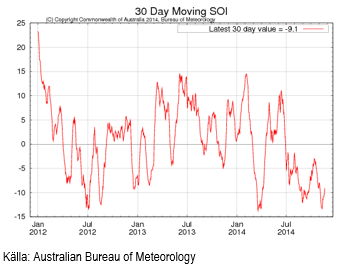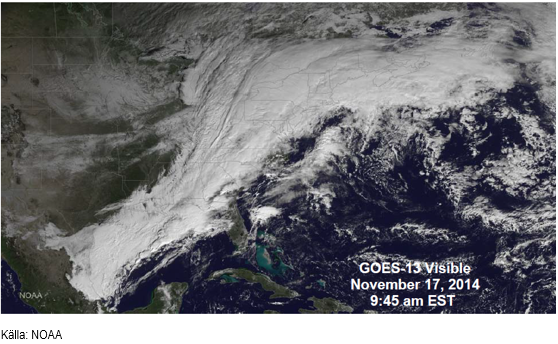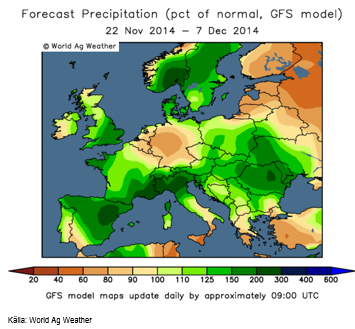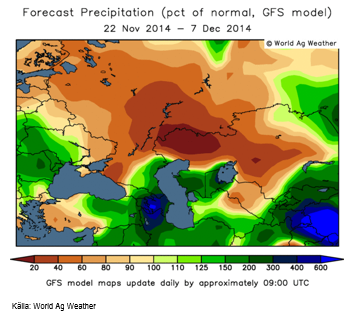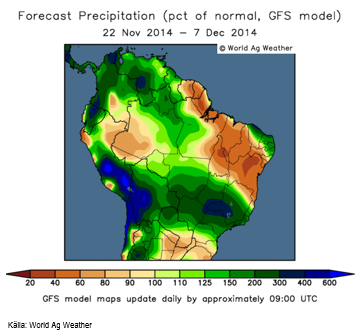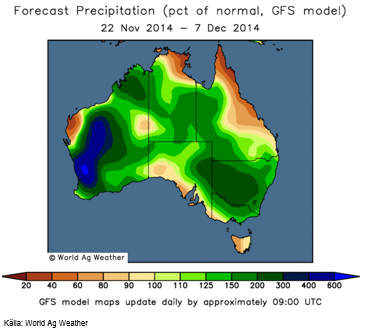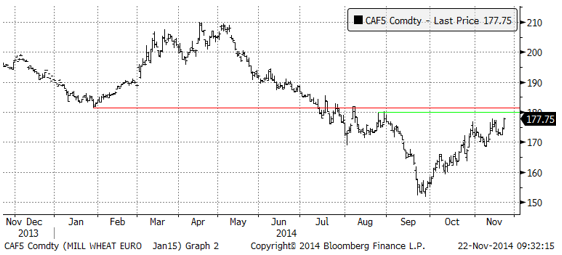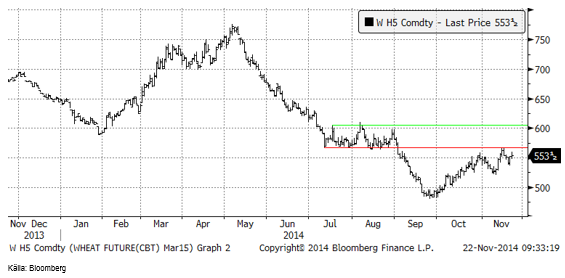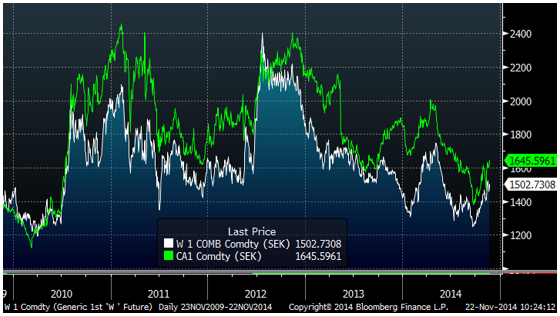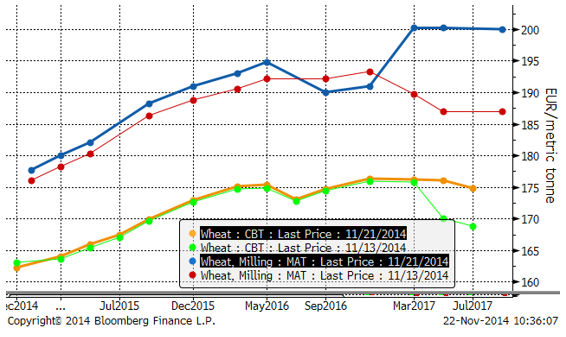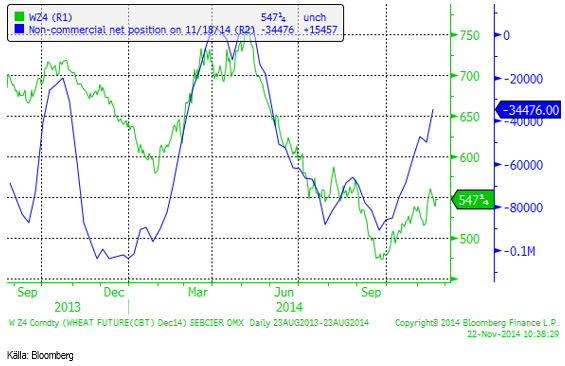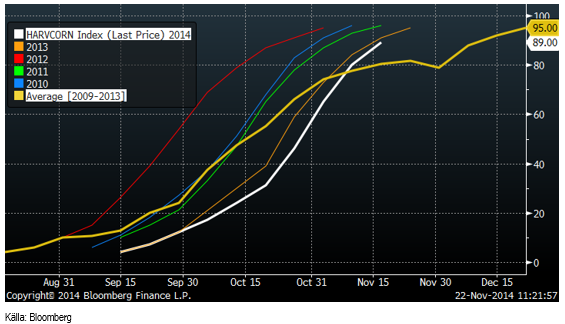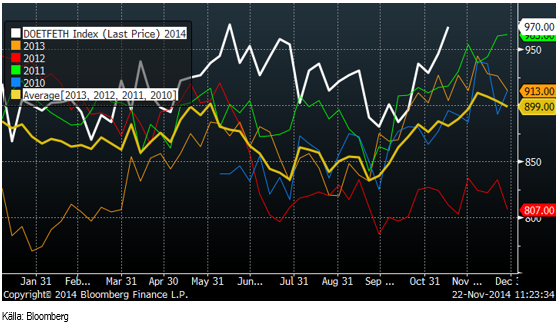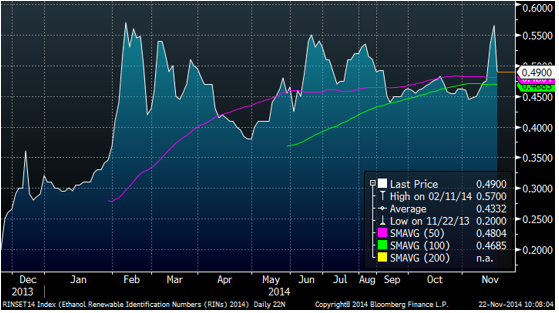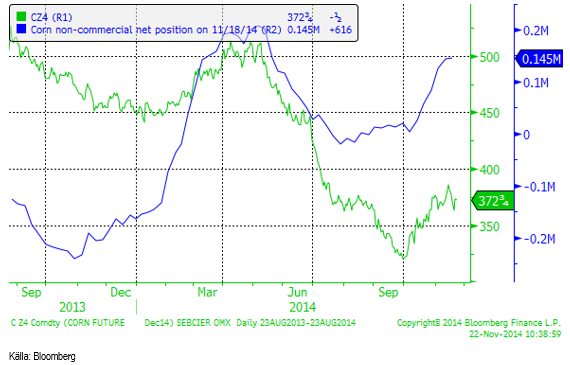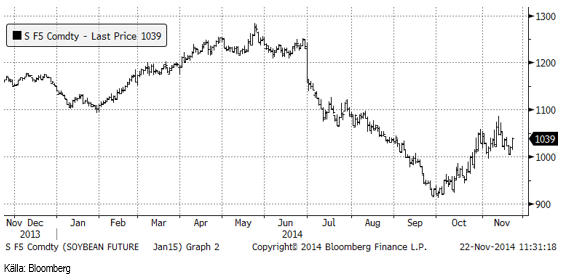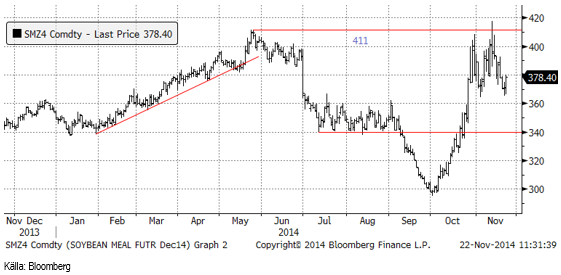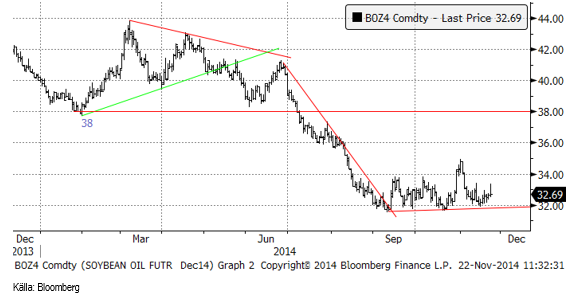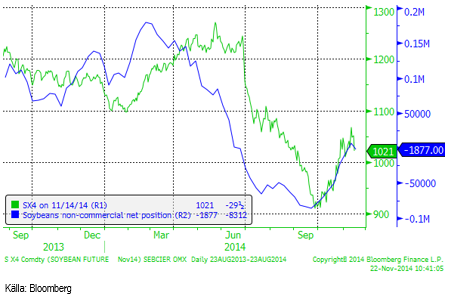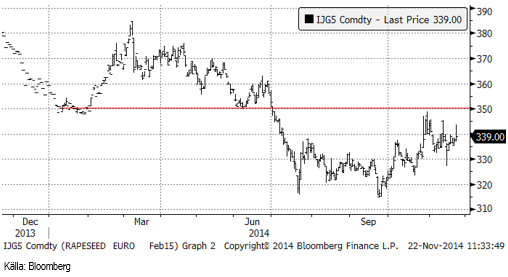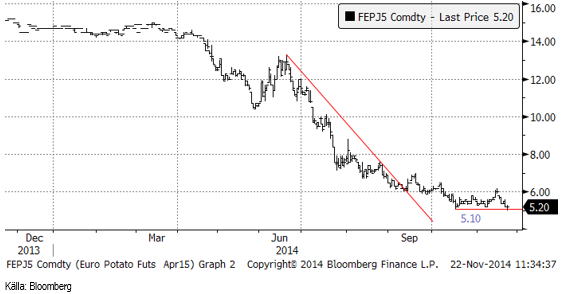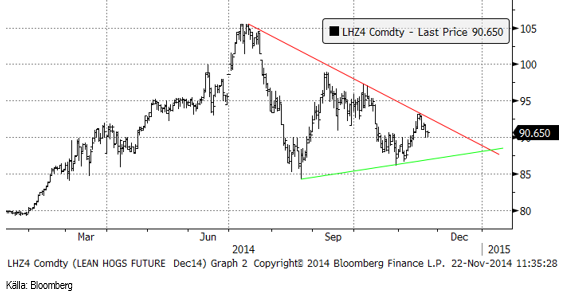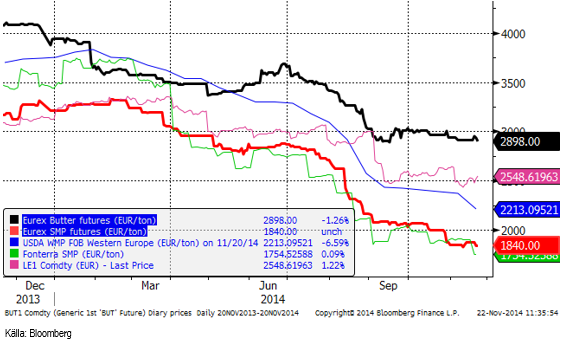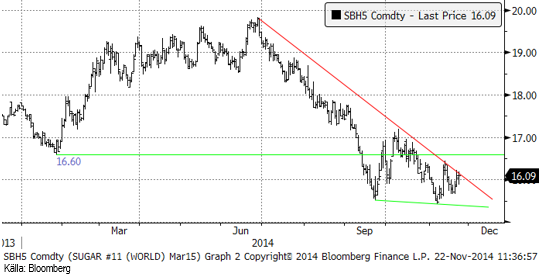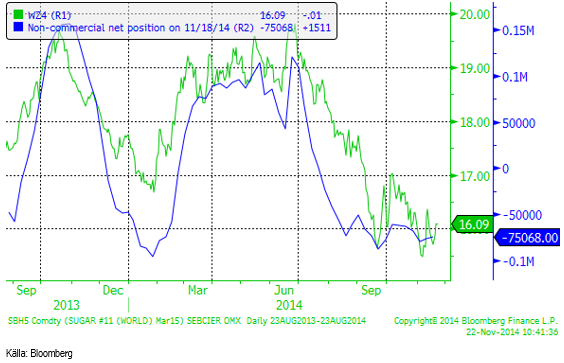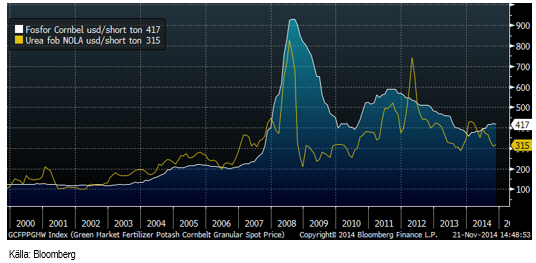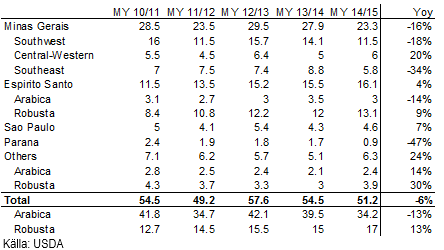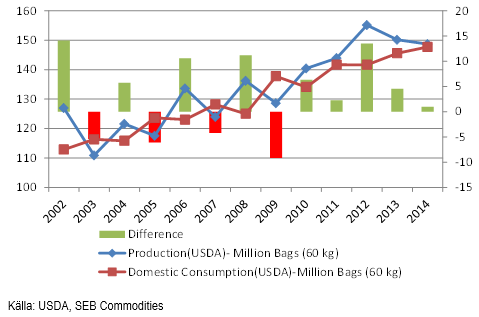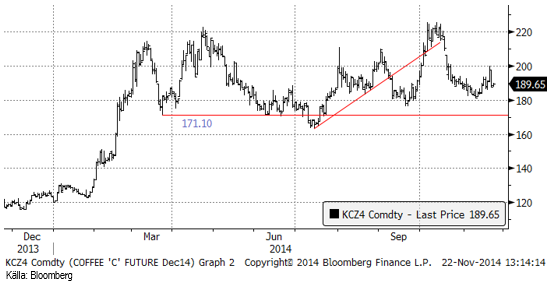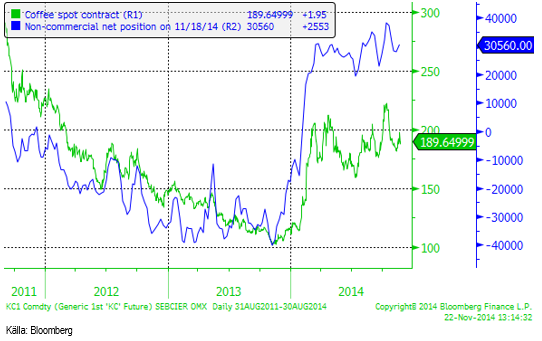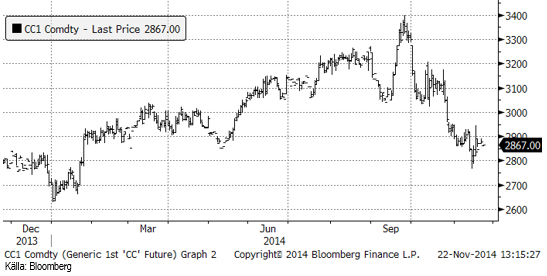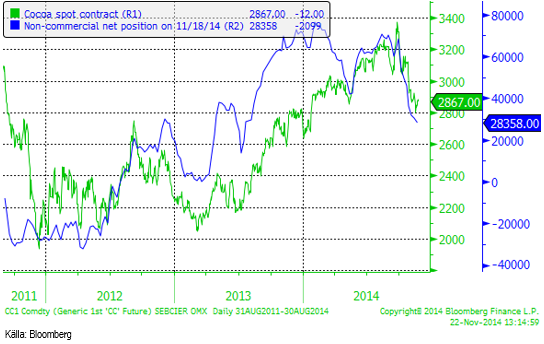Analys
SEB Jordbruksprodukter, 24 november 2014


 Marknaderna för jordbruksprodukter var ganska lugn i veckan. Oron för utvintring av höstvetet i USA har lagt sig. Franskt vete fortsätter att vinna exportordrar, i veckan både till Egypten och till USA, vilket ger stöd för en prisuppgång på Matif, men inte i Chicago.
Marknaderna för jordbruksprodukter var ganska lugn i veckan. Oron för utvintring av höstvetet i USA har lagt sig. Franskt vete fortsätter att vinna exportordrar, i veckan både till Egypten och till USA, vilket ger stöd för en prisuppgång på Matif, men inte i Chicago.
Priset på mjölkprodukter fortsätter att notera lägre priser. På Global Dairy Trade noterades det lägsta genomsnittliga priset på nästan 5 och ett halvt år.
Kinas PMI (inköpschefsindex) kom in lägre än förväntat på torsdagen. Väntat var 50.2 och PMI blev 50, alltså precis på gränsen mellan tillväxt i tillverkningsindustrin och tillbakagång. I fredags sänkte Kina styrräntan, förmodligen som ett svar på detta, och det fick såväl aktier som metaller och flera andra Kina-relaterade råvaror att lyfta kraftigt. Inköpschefsindex för Eurozonen kom in mycket lägre än förra månaden och marknaden hade förväntat sig en högre siffra än förra månaden. ECB sade samtidigt att de skulle göra ”vad som helst” för att skapa inflation, vilket fick kapital att flytta från euron till dollarn. Den ekonomiska tillväxten har problem överallt, utom i USA. Mer pengar leder på kort sikt till högre tillgångspriser, men inte nödvändigtvis till högre tillväxt och konsumtion (av mat, till exempel). Tvärtom kan lägre tillväxt faktiskt ge lägre pris på mat.
Marknaden har inte riktigt tagit till sig att det ser ut att bli ett El Niño från Jul. Ett sådant ger regn över Sydamerika, vilket ger en boost för produktionen av sojabönor och majs. Det ger också en bra start för odlingssäsongen på norra halvklotet. Inget av detta är positivt för prisutvecklingen på jordbruksprodukter.
Odlingsväder
NOAA publicerade sin långtidsprognos för december i torsdags och det ser gynnsamt ut för höstgrödorna. De förutspår att vädret i södra USA blir kallare än normalt och att det blir normal nederbörd i norra och centrala USA, vilket ger ytterligare snötäcke. Detta är i linje med den allmänna El Niño-stämning som jag rapporterade om förra veckan.
Det kan tilläggas att om El Niño verkligen slår in och håller i sig fram till våren, ger detta ett gynnsamt odlingsväder på norra halvklotet.
Southern Oscillation Index ligger vid -10.9 efter att ha fallit och nått -13.3 som lägst. Ett SOI under -8 kan indikera ett El Niño. I diagrammet nedan ser vi ett 30-dagars glidande medelvärde av SOI.
I USA väntas temperaturen fortsätta att ligga 5 till 10 grader under det normala i ’corn belt’. Resten av landet får normal temperatur, utom västkusten som blir varmare än normalt. Nederbörden i USA blir högre än normalt där det brukar regna och torrare än normalt där det brukar vara torrt (New Mexico, Arizona). Den enda avvikelsen är att Texas blir mycket blötare än normalt. Såsom är vanligt vid ett El Niño blir det blötare i Montana.
Nedan ser vi en satellitbild från GOES-13, som visar snöovädret som drog förbi tidigare i veckan. Notera att det ser ut att finnas ett snötäcke på marken väster om där snöovädret drar fram.
Noterbart för Europa är att Sverige och Norge får väsentligt mycket mer nederbörd än vad förra veckans prognos visade. Det påverkar elpriset negativt. Generellt sett förutspås ovanligt mycket nederbörd över Europa, utom över Benelux och Tyskland. Baltikum, Finland och Ryssland är dock torrare än normalt. Temperaturerna blir normala i hela Europa, utom i Baltikum och Ryssland där det blir några grader kallare än normalt.
North Atlantic Oscillation förutspås bli mer positiv. Ett negativt NAO ger kyla och vindstilla väder i Nordeuropa.
Ryssland ser i den senaste 14-dagarsprognosen fortsatt torrt ut. Nederbörden väntas ligga på mellan 40 och 60% av normal nederbörd. Västra Ukraina väntas däremot liksom i förra veckans prognos få upp till 3 gånger normal nederbörd. Temperaturen sjunker om en vecka till under det normala i Ryssland. Öster om Uralbergen sjunker temperaturen till 10 grader under det normala.
Nederbörden i Brasilien ökar från förra veckans tvåveckorsprognos. Onormalt mycket nederbörd fortsätter att förutspås för São Paulo, Minas Gerais, Goiás och Mato Grosso. I hörnet där dessa delstater möts väntas upp till fyra gånger normal nederbörd falla.
Notera nederbörden i Peru och norra Chile, som är typisk för El Niño, med upp till sex gånger normal nederbörd i prognosen. Från Peru rapporteras också att ansjovisen försvunnit från fiskebankarna, vilket också är ett säkert tecken på att El Niño är i antågande.
El Niño innebär också att Australien ska vara torrt, men det är det verkligen inte. Tvärtom faller i västra Australien upp till 7 gånger så mycket regn som normalt, medan den östra sidan får upp till 3 gånger så mycket som normalt. Hela kontinenten ser blötare ut än normalt. Detta är knappast bra för kvaliteten på vetet som skördas nu.
Vete
Trots oron för kylan i USA, var måndagens crop condition oförändrat på höga 60% good/excellent.
Tisdagens stora nyhet var att Frankrike lyckats sälja den största lasten av fodervete till USA. Det var den största lasten på 12 år.
Frankrike har vunnit en rad GASC-tendrar de senaste veckorna. Det beror delvis på att euron är svag mot dollarn. Torsdagens GASC vanns återigen av Soufflet, som fick sälja 60,000 ton 259.87 dollar inklusive frakt. Vi kan se av offerterna att den erbjöds till 243.74 dollar, så mellanskillnaden är frakt. Exklusive frakt motsvarar det ett pris på 194.20 euro per ton. När januarikontraktet på MATIF handlas på 174, motsvarar det alltså en premie på 20 euro per ton för 200 i falltal för vetet. Totalt offererades 300 kt franskt, 405 kt ryskt, 120 kt rumänskt och 55 kt ukrainskt vete. Värt att notera är att amerikanskt vete återigen inte ens ställde upp i budgivningen.
Ukrainas departement för ekonomisk utveckling estimerar årets skörd i landet till rekordhöga 63.2 mt, vilket är lite högre än förra årets 63 mt (som då inkluderade Krim). De estimerar veteproduktionen till 24 mt och majsskörden till 28 mt. USDA:s estimat är 24.5 mt respektive 27 mt. Alltså lite positivt med avseende på vetepris och lite negativt för majspris.
Argentinas skörd rapporterades i veckan vara klar till 22%, vilket är snabbare än förra årets 13% så här års. Skörden väntas vara klar i januari.
Vetepriset på Matif har segat sig upp till 177.75 euro per ton för januarileverans. Det franska vetet vinner ju exportordrar, så vetet handlas successivt upp. Strax över 180 finns ett motstånd, som marknaden borde få problem med.
Chicagovetet (mars) har inte utvecklat sig lika positivt som Matif, men så vinner inte heller det amerikanska vetet några exportordrar. Marknaden har inte lyckats ta sig över det tekniska motstånd som begränsar uppsidan.
Medan prisutvecklingen i dollartermer ser svag ut för vetepriset, får man en något annan bild när man räknar om priset till kronor per ton. I diagrammet nedan ser vi den senaste femårsperioden för priset på spotkontraktet på Matif respektive Chicago. Vi ser att priset på vete basis Chicago har gått upp från 1257 till 1502 kr sedan slutet av september. Matif har under tiden gått upp från 1392 till 1645 kr.
Nedan ser vi terminskurvorna i fredags och en vecka tidigare för Matif respektive Chicago. Det är contango på båda marknader. Här ser vi att den senaste veckan har Matifs terminskurva gått upp i euro, medan Chicagos faktiskt varit oförändrad, när vi räknar om den till euro.
Så slutligen till vad spekulanterna gjort i Chicagovetet. Vi ser att de har köpt tillbaka ytterligare 15,457 kontrakt och nu är nettosålda 34,476 kontrakt. Vid slutet av september var de nettosålda 90,000 kontrakt.
Majs
Decemberkontraktet CZ4 har gått ner med 2% sedan förra veckan och stängde i fredags på 385.25 cent.
Skörden av majs accelererade enligt måndagens rapport från 80 till 89% klart. Normal takt är 80%. Skördearbetet har gått fortare mot slutet.
Etanolproduktionen i USA ligger på 970,000 fat per dag. Det är nästan lika högt som den rekordvecka som noterades i mitten av juni med en produktionstakt på 972,000 fat om dagen. Etanolproduktionen har hämtat sig sedan en botten i början av år 2013 på 770,000 fat per dag, då den fallit från en topp på 963,000 fat vid årsskiftet 2011/2012.
EPA i USA har ännu inte bestämt hur mycket etanol som ska blandas in i amerikansk bensin under år 2014. Ett beslut kommer alltså att bli retroaktivt, vilket föranlett skrammel om stämningar i domstol från tillverkarna. Förseningen verkar bero på att presidenten ännu inte uttalat sig i frågan, vilket kan tolkas som att entusiasmen över stödet till förnybart bränsle har svalnat. Lagen infördes under Bush-eran år 2005 för att minska USA:s beroende av importerad olja och samtidigt ge stöd till amerikanska lantbrukare. Detta var innan ”råvaruboomen” tog fart på allvar och priset på majs hade legat på ungefär samma nivå sedan 1980. Läget idag är ett helt annat. Dels kommer USA att vara självförsörjande på olja inom fem år och dels är priset på majs avsevärt högre och spannmålsbönderna inte i behov av stöd på samma sätt. USA har reducerat utsläpp av CO2 väsentligt mycket mer än andra länder, t ex EU genom att använda mer naturgas, som produceras billigt med ny teknik (fracking). Stödet till etanol är troligtvis på upphällningen och presidentens tvekan att spendera pengar på detta är troligtvis ett tecken på våndan att fatta rätt beslut och politiskt korrekt beslut.
Renewable Identification Numbers (RINs) är ett slags certifikat man erhåller när man blandar en gallon av etanol i bensin. RINs kan sedan handlas som ett värdepapper, ungefär som en utsläppsrätt i EU. Priset på RINs har stigit i november, men föll ganska kraftigt i fredags från 0.57 dollar per gallon till 0.49 dollar. Prisfallet är sannolikt ett svar på den höga produktionen av etanol och farhågor om stödets vare eller inte vara.
Non-commercials var efter den senaste tidens lite ”sidledes” rörelse i priset på majs lite mindre på köpsidan. De är nu nettoköpta med 145,000 kontrakt och det är bara lite mer än förra veckan.
El Niño i antågande, som ger en boost åt nederbörden i Sydamerika och goda förutsättningar för odling på norra halvklotet i vår och spekulanter som redan är tämligen köpta redan gör det svårt att se positivt på prisutvecklingen. Vi fortsätter med neutral rekommendation.
Sojabönor
Sojabönorna (SF5) steg med 2% medan både sojamjöl och sojaolja steg med 1%. Crushers har alltså fått ännu bättre villkor sedan förra veckan. Januarikontraktet på sojabönor backade initialt under veckan, men fann stöd på 1000 cent och rekylerade upp till 1039 i fredags. Marknaden stängde på dagshögsta.
Sojamjölet utvecklades svagare än sojabönorna. Konsolideringsfasen som skett under hög volatilitet sedan slutet av oktober på mellan 370 och 420 dollar är ännu inte över. Det är oklart ur teknisk synvinkel om konsolideringen är en paus inför vidare prisuppgång eller en toppformation som följs av prisfall.
Sojaoljan ligger fortfarande i konsolidering strax över 32 cent per pund.
Skörden av sojabönor i USA avancerade från 90% skördat till 94%. Därmed är skörden nästan klar.
Amerikansk export av sojabönor var låg, men försäljningen av mjöl hög.
Non-commmercials sålde, som vi förutspådde förra veckan eftersom priset gått ner, drygt 8000 terminskontrakt på sojabönor och är därmed återigen nettosålda, men inte med mycket. Antagligen kommer rapporten på fredag, som visar ställnigen på tisdag, att visa att de köpt, eftersom priset gått upp sedan i tisdags.
Vi tror att det återigen ganska höga priset kan attrahera ytterligare areal i Brasilien. Crushers bör utnyttja tillfället att köpa sojabönsterminer och sälja terminer på mjöl och olja det kan sätta press på dessa två specifikt.
Raps
Februarikontraktet på rapsfrö steg med 1%, medan de längre kontrakten var oförändrade i pris sedan förra veckan. Motståndet på 350 euro begränsar uppsidan. Stöd finns vid 330. Det verkar finnas starka säljintressen, eftersom varje försök att handla upp priset stöter på säljare som snabbt trycker tillbaka priset.
Vi fortsätter med neutral rekommendation på raps.
Potatis
Potatisterminen sjönk med 13% (april). Priset var temporärt nere vid det tekniska stödet på 5.10 euro per 100 Kg, men stängde i fredags över den nivån på 5.20. Frågan är nu om 5.10 kommer att brytas eller hålla. Stödet har testats och hållit tre gånger de senaste två månaderna. Bryts nivån öppnar det för ytterligare prisfall, som kan bli stora i procent räknat. Om stödet håller, kan en uppgång till 6 euro ske, och till 8 euro som högst, enligt den tekniska analysen.
Gris
Lean hogs aprilkontrakt föll med 13% och decemberkontraktet med något mindre till 90.65 cent. Sedan i somras har svängningarna i priset blivit successivt mindre utan att priset trendat åt något håll. Detta brukar inte bli bestående, utan i regel följas av en ny trend, uppåt eller nedåt. Tumregeln är att invänta besked från marknaden och sedan haka på – uppåt eller nedåt. Det rimliga borde vara en ny fallande pristrend, eftersom PED-viruset är övervunnet.
Mjölk
Terminerna på SMP föll med 1 till 2% i veckan, medan terminerna på smör förändrades med 0 till -1%, olika för olika löptider. Global Dairy Trade-auktionen i tisdags noterades det genomsittliga priset 3.1% lägre, i 2561 dollar. Det är den lägsta noteringen sedan den 4 augusti 2009. Delvis är det en funktion av en superstark US-Dollar, men också förstås en tillika svag mjölkmarknad. På auktionen sjönk WMP med 5.1%, SMP med 5.7%, medan priset på smör steg med 6% och priset på cheddar steg med 5%. Vi kan se med blotta ögat att pristrenden fortfarande är fallande för såväl smör som SMP på EUREX.
EUREX senaste index för spotpriset på smör och SMP ger med aktuell växelkurs ett produkt-värde på mjölkråvara på 2.93 kr / Kg. Den sista oktober var priset 2.99 kr / Kg. Priset har alltså sjunkit med nästan 2% på tre veckor. Ett mejeri kan inte rimligen köpa in råvaran för över tre kronor kilot, tillverka smör och SMP och sälja dessa produkter för 2.93 Kr någon längre tid. Ytterligare sänkning av avräkningspris borde vara att vänta.
Socker
Regn i Brasilien tynger marknaden och i Uttar Pradesh i Indien börjar sockerindustrin att processa skörden av sockerrör mot slutet av månaden. Tekniskt rör sig priset inom en nedåtriktad triangelformation. Eftersom den är nedåtriktad är sannolikheten större för en prisuppgång än en nedgång när väl ett brott av triangelns ovansida eller undersida sker. Marknaden testar just nu den övre sidan och det skulle inte förvåna om det blev ett utbrott uppåt.
På lite spekulation går vi därför över till köprekommendation.
Non-commercials köpte 1500 kontrakt med är fortfarande maximalt sålda med 75,000 kontrakt.
Gödsel
Man hör ibland från politiskt håll att fosfor kommer att ta slut. Det finns ingen grund för det påståendet. Det finns ingen ”ändlig” råvara som konsumeras mindre av idag än för exempelvis 50 år sedan, undantaget asbest och kvicksilver. Att konsumtionen av dessa gått ner beror inte på att de tagit slut, utan på att intresset att använda dem minskat.
Nedan ser vi prisutvecklingen sedan år 2000 på fosfor i dollar per short ton i ’corn belt’ i USA och urea FOB New Orleans (NOLA), också i dollar per short ton. Prisutvecklingen är snarlik. Fosforpriset påverkas av att det tidigare har funnits en kartell, liknande OPEC för olja. Nu har kartellen övergått i ett oligopol. Substitut finns. Under andra världskriget utvanns den fosfor som finns i svensk järnmalm, vilket idag är något för dyrt i jämförelse med de rikare fyndigheter som finns på andra håll. Vi kan dock se att prisutvecklingen ganska väl följer prisutvecklingen på spannmål.
Kaffe
USDA publicerade en GAIN-rapport i veckan. De justerar upp prognosen för Brasiliens produktion av kaffe 2014/15 (i somras) till 51.2 miljoner säckar. Det är endast 6% lägre än förra året, enligt USDA:s siffor. CONAB estimerade i september skörden till 45.14 miljoner säckar. Även det var en uppjustering från CONAB:s estimat i maj. Nedan ser vi USDA:s senaste estimat för Brasiliens produktion för de senaste marknadsföringsåren (Marketing Year).
Nedan ser vi USDA:s estimat för global produktion och konsumtion av kaffe med skalan på västra axeln i miljoner säckar. Stapeldiagrammet visar överskott och underskott per år och skalan visas på högra y-axeln. Vi ser att inte ens i år blir det ett underskott, utan ett överskott på 0.96 miljoner säckar. De senaste åren har det producerats mer kaffe än vad som konsumerats, vilket pressade ner priset för en botten för ett år sedan. Torka har sedan drivit upp priset och gett respit för producenterna. I år skulle ha varit ett ”bra” år för odlarna i Brasilien, där arabican är en typisk ”vartannatsårs-gröda”. Nästa år kommer att vara ett sämre år enligt den cykeln, vilket gör att det ändå finns viss oro för utbudet det kommande året.
F.O. Licht rapporterade i torsdags att de tror att skörden av robusta i Vietnam bir 25.5 miljoner säckar för året som där börjar den 1 oktober 2014 och löper till den sista september 2015. Skörden börjar i oktober i Vietnam, till skillnad från Brasilien, där skörden börjar i april. Produktionen väntas bli 300,000 säckar mindre än 2013/14 när den uppgick till 25.8 miljoner säckar. Orsaken till den lägre produktionen är inte tillfällig, som i Brasilien, utan det finns en trend där avkastningen blir lägre pga åldrande träd.
F.O. Licht skriver också att de väntar sig att global produktion blir 145.7 miljoner säckar, medan konsumtionen blir 146 miljoner. Detta är i linje med vad man kunnat förstå tidigare under året efter nedjusteringen av Brasiliens skörd efter torkan i våras.
Det kom också rapporter om robustan i Vietnam har små bönor i år. Det kan också ha bidragit till prisuppgången i veckan.
Efter USDA-rapporten föll marknaden och prisuppgången räckte inte för att ta marknaden över 200 cent igen. Uppenbarligen finns många som tycker att 200 cent är ett bra pris att sälja på.
Som vi ser i nedanstående diagram är non-commercials köpte 2500 kontrakt från förra veckan. COT-rapporten avläses på tisdagskvällar och i tisdags hade marknaden stigit, vilket förklarar varför non-commercials köpte. Om priset fortsätter ner kommer vi att se att non-commercials har sålt igen.
Troligen får vi återigen en vecka med ”sidledes” prisrörelse. Det finns analytiker, framstående sådana, som tror att priset kommer att gå upp kraftigt. Jag är inte alls lika säker. Dels är den ekonomiska tillväxten svagare i världen och dels regnar det mer än normalt i Sydamerika. Får vi dessutom ett El Niño är haussen historia och sannolikheten för det är ganska hög.
Kakao
Kakaopriset gick upp från 2847 till 2867 i fredags, avseende spotkontraktet på ICE i New York.
ICCO sa i fredags att ”As far as the ICCO’s current projections are concerned, there is no immediate cause for concern about the supply of cocoa for the next five years”. De sa också att medan deras prognoser visar att underskott förmodligen kommer att uppstå, finns tillräckliga lager för att buffra dessa till dess produktionstakten ökar.
Non-commercials fortsätter sälja av terminer på kakao, förra veckan med 2100 kontrakt.
[box]SEB Veckobrev Jordbruksprodukter är producerat av SEB Commodities Sales desk och publiceras i samarbete och med tillstånd på Råvarumarknaden.se[/box]
Detta marknadsföringsmaterial, framtaget av SEB’s Commodities Sales desk, har upprättats enbart i informationssyfte.
Även om innehållet är baserat på källor som SEB bedömt som tillförlitliga ansvarar SEB inte för fel eller brister i informationen. Den utgör inte oberoende, objektiv investeringsanalys och skyddas därför inte av de bestämmelser som SEB har infört för att förebygga potentiella intressekonflikter. Yttranden från SEB’s Commodities Sales desk kan vara oförenliga med tidigare publicerat material från SEB, då den senare hänvisas uppmanas du att läsa den fullständiga rapporten innan någon åtgärd vidtas.
Dokumentationen utgör inte någon investeringsrådgivning och tillhandahålls till dig utan hänsyn till dina investeringsmål. Du uppmanas att självständigt bedöma och komplettera uppgifterna i denna dokumentation och att basera dina investeringsbeslut på material som bedöms erforderligt. Alla framåtblickande uttalanden, åsikter och förväntningar är föremål för risker, osäkerheter och andra faktorer och kan orsaka att det faktiska resultatet avviker väsentligt från det förväntade. Historisk avkastning är ingen garanti för framtida resultat. Detta dokument utgör inte ett erbjudande att teckna några värdepapper eller andra finansiella instrument. SEB svarar inte för förlust eller skada – direkt eller indirekt, eller av vad slag det vara må – som kan uppkomma till följd av användandet av detta material eller dess innehåll.
Observera att det kan förekomma att SEB, dess ledamöter, dess anställda eller dess moder- och/eller dotterbolag vid olika tillfällen innehar, har innehaft eller kommer att inneha aktier, positioner, rådgivningsuppdrag i samband med corporate finance-transaktioner, investment- eller merchantbankinguppdrag och/eller lån i de bolag/finansiella instrument som nämns i materialet.
Materialet är avsett för mottagaren, all spridning, distribuering mångfaldigande eller annan användning av detta meddelande får inte ske utan SEB:s medgivande. Oaktat detta får SEB tillåta omfördelning av materialet till utvald tredje part i enlighet med gällande avtal. Materialet får inte spridas till fysiska eller juridiska personer som är medborgare eller har hemvist i ett land där sådan spridning är otillåten enligt tillämplig lag eller annan bestämmelse.
Skandinaviska Enskilda Banken AB (publ) är ett [publikt] aktiebolag och står under tillsyn av Finansinspektionen samt de lokala finansiella tillsynsmyndigheter i varje jurisdiktionen där SEB har filial eller dotterbolag.
Analys
Tightening fundamentals – bullish inventories from DOE

The latest weekly report from the US DOE showed a substantial drawdown across key petroleum categories, adding more upside potential to the fundamental picture.

Commercial crude inventories (excl. SPR) fell by 5.8 million barrels, bringing total inventories down to 415.1 million barrels. Now sitting 11% below the five-year seasonal norm and placed in the lowest 2015-2022 range (see picture below).
Product inventories also tightened further last week. Gasoline inventories declined by 2.1 million barrels, with reductions seen in both finished gasoline and blending components. Current gasoline levels are about 3% below the five-year average for this time of year.
Among products, the most notable move came in diesel, where inventories dropped by almost 4.1 million barrels, deepening the deficit to around 20% below seasonal norms – continuing to underscore the persistent supply tightness in diesel markets.
The only area of inventory growth was in propane/propylene, which posted a significant 5.1-million-barrel build and now stands 9% above the five-year average.
Total commercial petroleum inventories (crude plus refined products) declined by 4.2 million barrels on the week, reinforcing the overall tightening of US crude and products.


Analys
Bombs to ”ceasefire” in hours – Brent below $70

A classic case of “buy the rumor, sell the news” played out in oil markets, as Brent crude has dropped sharply – down nearly USD 10 per barrel since yesterday evening – following Iran’s retaliatory strike on a U.S. air base in Qatar. The immediate reaction was: “That was it?” The strike followed a carefully calibrated, non-escalatory playbook, avoiding direct threats to energy infrastructure or disruption of shipping through the Strait of Hormuz – thus calming worst-case fears.

After Monday morning’s sharp spike to USD 81.4 per barrel, triggered by the U.S. bombing of Iranian nuclear facilities, oil prices drifted sideways in anticipation of a potential Iranian response. That response came with advance warning and caused limited physical damage. Early this morning, both the U.S. President and Iranian state media announced a ceasefire, effectively placing a lid on the immediate conflict risk – at least for now.
As a result, Brent crude has now fallen by a total of USD 12 from Monday’s peak, currently trading around USD 69 per barrel.
Looking beyond geopolitics, the market will now shift its focus to the upcoming OPEC+ meeting in early July. Saudi Arabia’s decision to increase output earlier this year – despite falling prices – has drawn renewed attention considering recent developments. Some suggest this was a response to U.S. pressure to offset potential Iranian supply losses.
However, consensus is that the move was driven more by internal OPEC+ dynamics. After years of curbing production to support prices, Riyadh had grown frustrated with quota-busting by several members (notably Kazakhstan). With Saudi Arabia cutting up to 2 million barrels per day – roughly 2% of global supply – returns were diminishing, and the risk of losing market share was rising. The production increase is widely seen as an effort to reassert leadership and restore discipline within the group.
That said, the FT recently stated that, the Saudis remain wary of past missteps. In 2018, Riyadh ramped up output at Trump’s request ahead of Iran sanctions, only to see prices collapse when the U.S. granted broad waivers – triggering oversupply. Officials have reportedly made it clear they don’t intend to repeat that mistake.
The recent visit by President Trump to Saudi Arabia, which included agreements on AI, defense, and nuclear cooperation, suggests a broader strategic alignment. This has fueled speculation about a quiet “pump-for-politics” deal behind recent production moves.
Looking ahead, oil prices have now retraced the entire rally sparked by the June 13 Israel–Iran escalation. This retreat provides more political and policy space for both the U.S. and Saudi Arabia. Specifically, it makes it easier for Riyadh to scale back its three recent production hikes of 411,000 barrels each, potentially returning to more moderate increases of 137,000 barrels for August and September.
In short: with no major loss of Iranian supply to the market, OPEC+ – led by Saudi Arabia – no longer needs to compensate for a disruption that hasn’t materialized, especially not to please the U.S. at the cost of its own market strategy. As the Saudis themselves have signaled, they are unlikely to repeat previous mistakes.
Conclusion: With Brent now in the high USD 60s, buying oil looks fundamentally justified. The geopolitical premium has deflated, but tensions between Israel and Iran remain unresolved – and the risk of missteps and renewed escalation still lingers. In fact, even this morning, reports have emerged of renewed missile fire despite the declared “truce.” The path forward may be calmer – but it is far from stable.
Analys
A muted price reaction. Market looks relaxed, but it is still on edge waiting for what Iran will do

Brent crossed the 80-line this morning but quickly fell back assigning limited probability for Iran choosing to close the Strait of Hormuz. Brent traded in a range of USD 70.56 – 79.04/b last week as the market fluctuated between ”Iran wants a deal” and ”US is about to attack Iran”. At the end of the week though, Donald Trump managed to convince markets (and probably also Iran) that he would make a decision within two weeks. I.e. no imminent attack. Previously when when he has talked about ”making a decision within two weeks” he has often ended up doing nothing in the end. The oil market relaxed as a result and the week ended at USD 77.01/b which is just USD 6/b above the year to date average of USD 71/b.

Brent jumped to USD 81.4/b this morning, the highest since mid-January, but then quickly fell back to a current price of USD 78.2/b which is only up 1.5% versus the close on Friday. As such the market is pricing a fairly low probability that Iran will actually close the Strait of Hormuz. Probably because it will hurt Iranian oil exports as well as the global oil market.
It was however all smoke and mirrors. Deception. The US attacked Iran on Saturday. The attack involved 125 warplanes, submarines and surface warships and 14 bunker buster bombs were dropped on Iranian nuclear sites including Fordow, Natanz and Isfahan. In response the Iranian Parliament voted in support of closing the Strait of Hormuz where some 17 mb of crude and products is transported to the global market every day plus significant volumes of LNG. This is however merely an advise to the Supreme leader Ayatollah Ali Khamenei and the Supreme National Security Council which sits with the final and actual decision.
No supply of oil is lost yet. It is about the risk of Iran closing the Strait of Hormuz or not. So far not a single drop of oil supply has been lost to the global market. The price at the moment is all about the assessed risk of loss of supply. Will Iran choose to choke of the Strait of Hormuz or not? That is the big question. It would be painful for US consumers, for Donald Trump’s voter base, for the global economy but also for Iran and its population which relies on oil exports and income from selling oil out of that Strait as well. As such it is not a no-brainer choice for Iran to close the Strait for oil exports. And looking at the il price this morning it is clear that the oil market doesn’t assign a very high probability of it happening. It is however probably well within the capability of Iran to close the Strait off with rockets, mines, air-drones and possibly sea-drones. Just look at how Ukraine has been able to control and damage the Russian Black Sea fleet.
What to do about the highly enriched uranium which has gone missing? While the US and Israel can celebrate their destruction of Iranian nuclear facilities they are also scratching their heads over what to do with the lost Iranian nuclear material. Iran had 408 kg of highly enriched uranium (IAEA). Almost weapons grade. Enough for some 10 nuclear warheads. It seems to have been transported out of Fordow before the attack this weekend.
The market is still on edge. USD 80-something/b seems sensible while we wait. The oil market reaction to this weekend’s events is very muted so far. The market is still on edge awaiting what Iran will do. Because Iran will do something. But what and when? An oil price of 80-something seems like a sensible level until something do happen.
-

 Nyheter3 veckor sedan
Nyheter3 veckor sedanMahvie Minerals växlar spår – satsar fullt ut på guld
-

 Nyheter4 veckor sedan
Nyheter4 veckor sedanUppgången i oljepriset planade ut under helgen
-

 Nyheter4 veckor sedan
Nyheter4 veckor sedanLåga elpriser i sommar – men mellersta Sverige får en ökning
-

 Nyheter3 veckor sedan
Nyheter3 veckor sedanJonas Lindvall är tillbaka med ett nytt oljebolag, Perthro, som ska börsnoteras
-

 Analys3 veckor sedan
Analys3 veckor sedanA muted price reaction. Market looks relaxed, but it is still on edge waiting for what Iran will do
-

 Nyheter3 veckor sedan
Nyheter3 veckor sedanOljan, guldet och marknadens oroande tystnad
-

 Analys4 veckor sedan
Analys4 veckor sedanVery relaxed at USD 75/b. Risk barometer will likely fluctuate to higher levels with Brent into the 80ies or higher coming 2-3 weeks
-

 Nyheter3 veckor sedan
Nyheter3 veckor sedanDomstolen ger klartecken till Lappland Guldprospektering


